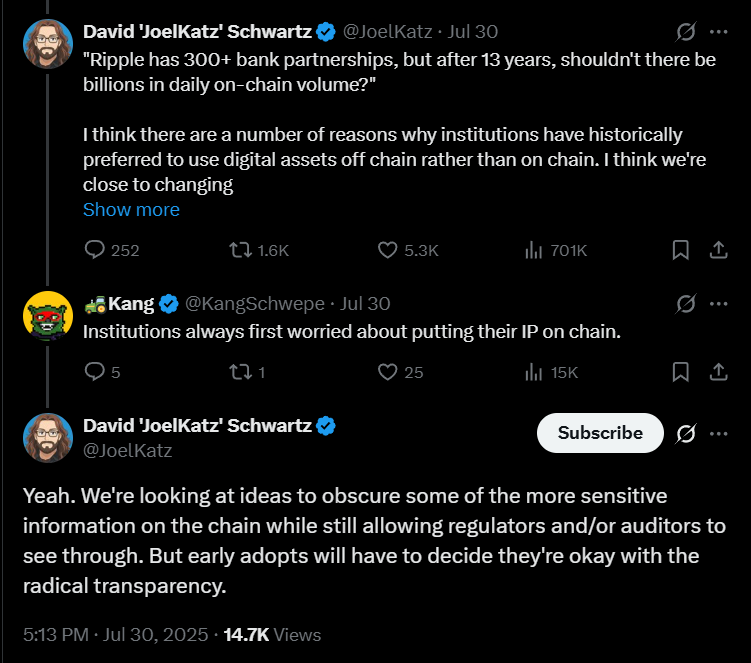A viral Twitter thread by popular finance YouTuber Andrei Jikh reignited scrutiny over XRP’s real-world utility. The post prompted Ripple CTO David Schwartz and other crypto figures to publicly respond.
The exchange laid bare the growing tension between XRP’s original promise and its current adoption status, despite Ripple’s claims of over 300 bank partnerships.
Why XRP Ledger Doesn’t Have More On-Chain Volume
Andrei Jikh, with over 2.5 million subscribers, questioned why, after 13 years, there isn’t billions in daily on-chain volume flowing through the XRP Ledger (XRPL).
SponsoredHe challenged the idea that XRP, as a bridge currency, still solves a meaningful problem in a world increasingly dominated by stablecoins and central bank digital currencies (CBDCs).
“If XRP is volatile, why use it over stablecoins for transfers?” Jikh asked. “Why would any institution want to hold a volatile token for payments?”
The thread quickly gained traction, sparking thousands of reposts and drawing responses from Ripple’s top technologist and community leaders.
Even Ripple Doesn’t Use XRP On Decentralized Exchanges
Ripple CTO, David Schwartz, acknowledged the sluggish pace of on-chain adoption. He attributed it to regulatory and compliance concerns.
“Even Ripple can’t use the XRPL DEX for payments yet,” Schwartz admitted, citing the risk of a terrorist providing liquidity, a scenario that complicates usage by regulated entities. He pointed to upcoming features like permissioned domains as solutions to this barrier.
On the volatility question, Schwartz said XRP’s speed minimizes risk and likened its use to holding a bridge currency for flexibility.
Sponsored Sponsored“A bridge currency only works if someone is holding it so that you can get it precisely when you need it,” he explained.
Still, he admitted that institutional comfort with on-chain transparency remains a challenge. Apparently, Ripple is exploring ways to obscure sensitive data on-chain for early adopters.

Debate Over Stablecoins vs XRP
One of the sharpest points of debate centered on whether XRP is still needed as a bridge currency when stablecoins can already serve that role.
SponsoredSchwartz argued that no single stablecoin can dominate due to jurisdictional limits and currency peg constraints.
“If we’re in a multi-stablecoin world, it still makes sense to have a neutral bridge asset like XRP,” he said.
But Jikh pushed back, questioning the practical need for XRP in that scenario, especially when CBDCs or local stablecoins could provide the same service without exposure to price volatility.
Others joined the thread to offer both support and criticism.
Former Ripple Director Matt Hamilton clarified that most Ripple bank partners use RippleNet, a separate off-chain network, and not the public XRPL.
He emphasized that RippleNet and XRPL are distinct. Ripple’s enterprise adoption hasn’t necessarily translated into on-chain XRP volume.
Sponsored SponsoredMeanwhile, critics claimed that many partnerships never materialized. They pointed to XRP’s low Total Value Locked (TVL), lack of smart contract support, and its centralized validator set as evidence that the project is no longer competitive.
“XRP is only a gas token now… ranked 48th in TVL,” one critic said. “Why would any institution opt for XRPL when Ethereum offers better decentralization and composability?”
Jikh also questioned why companies like BlackRock would choose XRPL for tokenization when they could build proprietary or Ethereum-based solutions, as Robinhood did with Arbitrum.
Schwartz responded with an analogy to Circle, which doesn’t run its own blockchain for USDC. The Ripple CTO implied that multi-chain deployment and interoperability are more important than exclusive control.
The viral thread exposed a core challenge for Ripple. That is bridging the gap between institutional adoption and on-chain XRP utility.

